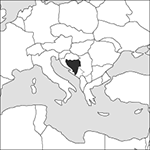
Capital:
Sarajevo
Area:
51,197 sq km (19,767 sq miles)
Population:
3,875,723 (2012 est)
Currency:
1 marka = 100 feninga
Religions:
Muslim 40.0%; Eastern Orthodox 31.0%; Roman Catholic 15.0%
Ethnic Groups:
Bosniak 48.0%; Serb 37.1%; Croat 14.3%
Languages:
Bosnian, Croatian, Serbian (all official)
International Organizations:
UN; OSCE; Council of Europe; Euro-Atlantic Partnership Council
A country in south-east Europe, in the Balkan Peninsula. It is bordered by Croatia to the north and west, Serbia to the east, and Montenegro to the south-east.
Physical
The country is mostly mountainous and wooded. It has a short Adriatic coastline.
Economy
The poorest of the former Yugoslav republics, Bosnia and Herzegovina suffered severe economic disruption from the civil war (1992–95). It has a variety of mineral resources, including coal, iron, copper, chrome, manganese, cinnabar, zinc, and mercury. Livestock are raised, and the principal crops are cereals, fruits, and vegetables. Industries include mining, steel, vehicle assembly, and textiles. Many Bosnians are migrant workers in Western Europe.
History
First inhabited by the Illyrians, the region became part of the Roman province of Illyricum. Slavs settled in the 7th century and, in 1137, it came under Hungarian rule. The Ottomans invaded in 1386 and after much resistance made it a province in 1463. They governed through Bosnian nobles, many of whom became Muslim, though much of the population became rebellious as Ottoman power declined. During the early 18th century Austrian forces began to push the Turks back. The rise of Pan-Slavism provoked revolts in 1821, 1831, and 1837. A revolt in 1875 brought Austrian occupation, which was consolidated by formal annexation into Austria-Hungary in 1908. This provoked protest from Serbia and Russia. An international crisis only subsided when Germany threatened to intervene. Serbs continued to protest and to indulge in terrorist activity, culminating in the assassination of the Archduke Francis Ferdinand and his wife in the capital Sarajevo in 1914. This sparked off World War I, after which Bosnia was integrated into the new Kingdom of Serbs, Croats, and Slovenes, later renamed Yugoslavia. During World War II the two provinces were incorporated into the German puppet state of Croatia, and were the scene of much fighting by the Yugoslav partisans. After the war they were integrated into Tito’s communist Yugoslavia.
Alija Izetbegović became President in 1990. In 1992, as Yugoslavia disintegrated, the mainly Muslim population of Bosnia and Herzegovina voted to become an independent country in a referendum. Although most Western countries recognized this decision, areas occupied mainly by the Serb and Croat minorities proclaimed themselves independent of the Muslim-dominated government and all three groups began fighting for territory. Attempts by the UN and the European Community to mediate in the ensuing ferocious civil war made little headway. The three main factions agreed in principle to Bosnia and Herzegovina being a federal nation with regions based on ethnic groupings but failed to agree on the borders of the proposed regions.
In April 1992 the Serbs besieged Sarajevo; by the end of that year, with backing from the Serb-led Yugoslav army, they had taken possession of over two-thirds of the country. Although a UN peacekeeping force intervened to defend Muslims and others fleeing from “ethnic cleansing”, it was unable to prevent thousands of civilians from being massacred. In 1994 NATO shot down Serb fighter planes that were flying in the UN-established “no-fly zone” and bombed Serb ground targets. That same year Bosnian Muslims (Bosniaks) and Bosnian Croats formed an alliance, and by mid-1995, with support from the Croatian army, they had recaptured a large amount of territory from the Serbs. Further NATO air strikes led to the lifting of the siege of Sarajevo in September 1995. In December 1995 a US-brokered peace deal, the Dayton Accord, was signed. This stated that although Bosnia and Herzegovina would remain a single state with unchanged borders, it would henceforth be divided into a Bosnian–Croat Federation in the west and a Bosnian Serb Republic in the north and east. Although there has been no resumption of full-scale violence, a number of serious problems remain—notably the resettlement of many thousands of refugees and the capture and prosecution of war criminals on all sides. In 1996 Izetbegović was re-elected as the chairman of a new tripartite rotating presidency, serving alongside a Serb and a Croat. The implementation of the non-military aspects of the Dayton Accord lies with an internationally appointed High Representative, who is effectively the supreme civilian authority in Bosnia and Herzegovina. NATO was responsible for military peacekeeping operations until December 2005, when it was replaced by an EU force. High unemployment led to violent anti-government demonstrations in 2014. The Presidency is now formed by a three-member body (one Bosniak, one Croat and one Serb) serving one four-year term, with the chairmanship rotating every eight months. The country signed a Stabilisation and Association Agreement with the EU in early 2015.
- Klug, Sir Aaron
- klystron
- K magnitude
- K-map
- kmol
- KMP algorithm
- knapsack problem
- knee-jerk reflex
- knee twin
- knick point
- knife-edge test
- knighthood
- Knight Hospitaller
- Knights of Labor
- Knight Templar
- knob and kettle
- Knobby Terrain
- knock and lochan
- knockin
- knocking
- knock-on effect
- knockout
- knockout drum
- Knoevenagel reaction
- Knossos culture